RECOIL OFFGRID Survival Lost In The Wild Survival Tips – Get Lost
In This Article
In today's world of 24-hour news cycles, constant connectivity, and digital addiction, the idea of getting lost in nature can seem comforting. But, for anybody who's ever experienced it, the reality can be downright terrifying. None of us enjoy the feeling of being vulnerable, alone, or in physical danger. But these risks are inherent with any activity that takes us into the wilderness.
If we can figure out how and why people get lost, we can plan to be ahead of the curve and simply enjoy the outdoors. To this end, we've assembled a guest panel of search-and-rescue (SAR) experts. All are seasoned professionals with decades of experience, and each hails from a different corner of the country with unique concerns about weather, terrain, and availability of resources.
They were incredibly generous sharing both time and knowledge so that you can be better prepared for your next adventure.

RECOIL OFFGRID: What are the two most common mistakes people make that contribute to them getting lost?
Hank Janssen: There are several recurring themes we see again and again with people getting lost. The biggest one is people going off trail, either because they think they know where they are or try to take a shortcut. Following the wrong trail is also particularly common. Sometimes people go off trail to see a landmark or stream or some such thing and then get completely turned around. The second most common mistake is underestimating the environment they're in — the impact that things like weather and terrain have on their ability to function and follow trail.
In both these cases we see people make poor decisions that get them into trouble. We have seen people wander over 15-plus miles from the location where they initially realized they were lost. That makes it incredibly difficult for a SAR team to find them.
Joey Nickischer: The most common mistakes made are going off trail and not being prepared for the hike. If you stay on the trail, your rescue is almost guaranteed — it's the most obvious place SAR personnel will look. For every foot you venture off trail, the odds of you getting found in a timely manner drop precipitously. Hike preparation varies widely, but the 10 essentials [see sidebar] are a good place to start. Along with that goes the knowledge of how to use those 10 essentials! They're useless without knowledge.
I've always preached travel light and have equipment that can be used for more than one purpose. A compass might also come with a mirror that can be used for signaling and a magnifying lens that might help to start a fire. Bandages can be used as kindling, a magnesium fire-starter can be used as a bright flashing light, a tarp can be used to catch rainwater, etc.
It's also helpful to have an emergency plan in place with a trusted friend or relative. When I go hiking, I chat with a reliable friend to let them know that I'm going hiking and verify that they're available to be my point of contact should something go wrong. Then I text/email them my itinerary including what trail(s) I will be on, who I'm with, what my destination is, and what time I expect to return. And most importantly, I stick to the itinerary, unless I'm able to verify my friend has gotten word of a change in plans. They're also informed to notify the authorities if I'm more than an hour overdue.
Gary Presson: 1) Not having a plan. Preplan your route before you even arrive at the trailhead. Enter your important checkpoints into your GPS if you use one or have your route marked on your map. Give a copy of your route, either map or a list of waypoints, to someone who can notify the authorities if you don't return by an established time and date.
2) Taking a shortcut off the established trail. I'm just as guilty of this as anyone. However, I'll take a few minutes to study the map and analyze the terrain before I attempt a shortcut. In the Northwest, the trails are there for a reason. Most of the time they're the quickest and most efficient way to travel even though they can be significantly longer.
Once you realize you're lost, what's the most advisable “movement plan?”
HJ: What we recommend is for people to stay where they are, which is hard because people get very anxious and convince themselves that the trail/parking lot is “just up ahead,” frequently getting themselves into more trouble. Having said that, there are a few simple things that'll help you and the SAR teams — if possible, stay close to water or an open clearing. Water will help you stay alive and a clearing gives us a better view from the air. But do not go out of your way to look for either.
JN: While most experts say to stay put, there isn't a straight answer for this one. In general, backtrack a little if you're certain of your track. If that doesn't solve your problem, stay put, stay as visible as possible, and call for help. You want to make yourself a big, easy target for searchers. That bright blue tarp strung up at eye level can be seen from a long distance, as can a small, smoky fire.
GP: If you are confident that you can backtrack your route, it is probably your best course of action. If you're totally lost or injured, then stay put.
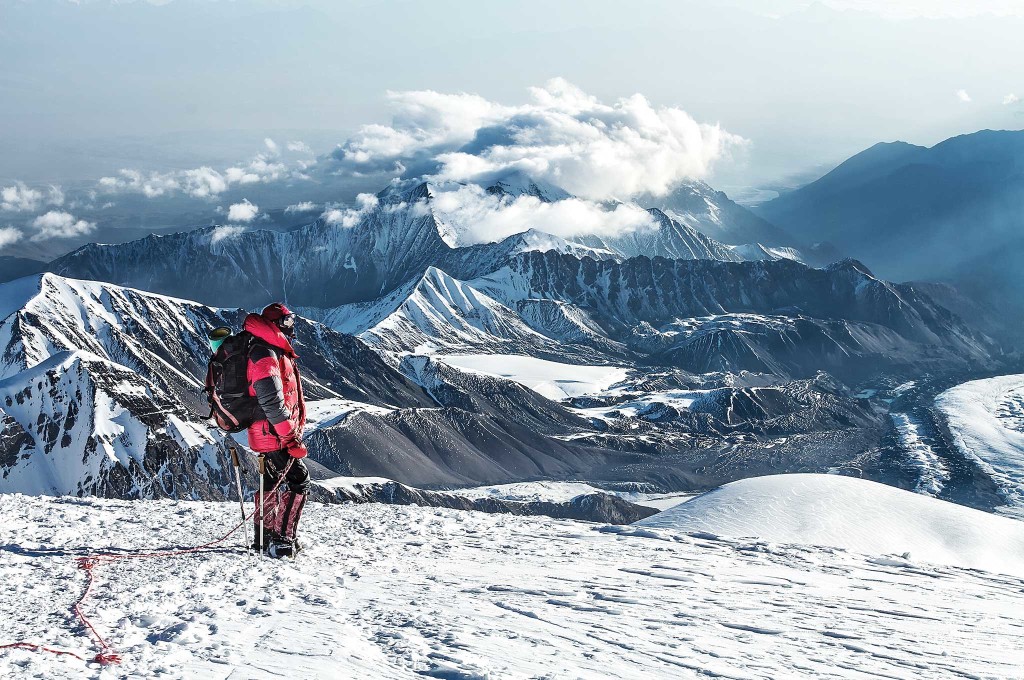
Regardless of the season, the ability to build a fire is critical for lifesaving warmth and possibly signaling...
If you had to pick a “most important” skill to get a lost person through until a SAR team can get to them, what would it be?
HJ: The area we do SAR in is the Pacific Northwest; the backcountry is wild, and the weather changes on you very fast. I've been on searches where the helicopter dropped me and my dog on top of a mountain at 80 degrees F, and they were unable to pick me up at the end of the day because it was snowing or fogged in. That being said, for survival the most important abilities to have are to create a shelter from the weather and make a fire. But both require some practice.
JN: The most important “skill” is probably patience. Patience that help is coming and to not keep moving from location to location. Patience in building that fire with limited resources. Patience to sit and think about your predicament and how to safely improve it.
Other “most important” skills are going to vary based on your terrain and climate. The rule of three states you cannot live more than three minutes without air, three days without water, and three weeks without food. Work with that knowledge to improve your situation. In a desert environment, water and shelter from the sun are going to be vital. In most other places, your biggest threat is going to be exposure. Touching anything, including the ground, that's less than body temperature is going to start sucking heat out of you, not to mention the ambient temperature and wind. Insulate yourself against the cold.
GP: In the Northwest, I'd say that shelter building is a very important skill to have. Summer snows in the high country aren't that unusual, and exposure can set in quickly. Staying in the elements can quickly result in hypothermia, and everything will go downhill from there. You don't have to look very far for some downed trees to quickly throw up a tarp and get out of the elements. Also, know how to build a snow cave if you decide to trek out in the winter months.
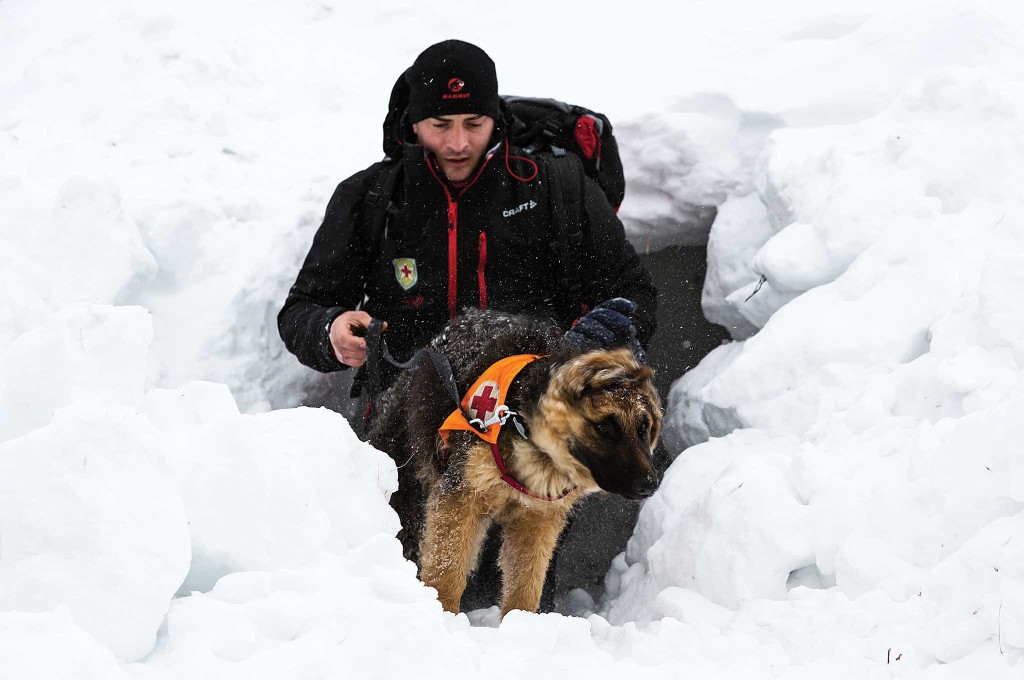
Would you know how to build a snow shelter if your life depended on it. See RECOIL Issue 11 for our article on how to...
If you knew before you hit the trail that you were going to get lost, what three items/pieces of gear would you make sure you packed?
HJ: A survival tarp. I prefer those to the lightweight Mylar survival blankets, which are really a single-use item. A survival tarp is usually bright red on one side and has reflective material on the other side and they're pretty heavy duty. With a survival tarp you can make a shelter, a bivvy bag, an emergency blanket, a rainwater collector, etc. I have been doing SAR for 20-plus years, and I just now replaced the one I got 20 years ago. In SAR training I use this thing all the time. They're light, cheap, la st forever, and pack down to nothing.
I recently added to my essential survival gear a Garmin InReach Explorer plus. The thing is amazing and I have found few places here where the bidirectional satellite communications didn't work. It has a map built-in, and you can send text messages via satellite. And I found the battery to last 80 hours or so in the field. But they're not cheap and require a subscription. I do five-plus-day off-trail backpacking trips, and the thing has changed the way I communicate in the field. But it's a piece of electronics, so don't solely rely on it. Our teams always have a GPS unit and paper map of the area as backup. At a minimum, try to have a map and compass and know how to use them.
Fire-starting material. Do not rely on one way to light a fire. Have two or more different ways to start a fire. I carry a cheap BIC lighter, a traditional ferrocerium rod and metal striker (they take practice to use effectively), and waterproof matches in a waterproof case. Additionally, I have dry fire-starting material — usually burlap string or fire-starter blocks.
I know I'm exceeding three items, but also something to filter or purify water with.
JN: Water, map, and compass. Almost everything else can be improvised.
GP: 1) A tarp. Get out of the elements as quickly as possible. 2) Fire-starting gear. Once you get out of the elements, stay warm. 3) A good multipurpose knife. There are hundreds of different models to choose from. Some even have compartments for fire-starting gear and other survival equipment.
Is there any last advice or words of wisdom that you'd give to someone awaiting rescue?
HJ: Getting lost is surprisingly easy. We get on average 50-plus SAR requests a year, and we're a small volunteer group. Pack a few essentials if you go out like water, food, and the items I list above, even if you only go out for an hour or so. Always let people know where you're going, call or text a family member of friend telling them where you are and when you have gotten back. Backcountry SAR starts from the last known location, and we work out from that. It's hard to do that if the only thing we know is that you didn't come home, but never told anybody where you went.
This one is easier said than done: Do not panic when you get lost. Take a deep breath, assess the situation and try to stay where you are. Your first priority is to keep yourself and whomever you're with safe.
It's amazing what shelter, fire, and food/water will do to raise your spirit and significantly increase your chances of survival. You can live without food for a while, but water is essential.
Do not feel discouraged if you're not found within 24 hours, here in the PNW the cavalry is usually mobilized to come find you, and we don't give up after 24 hours.
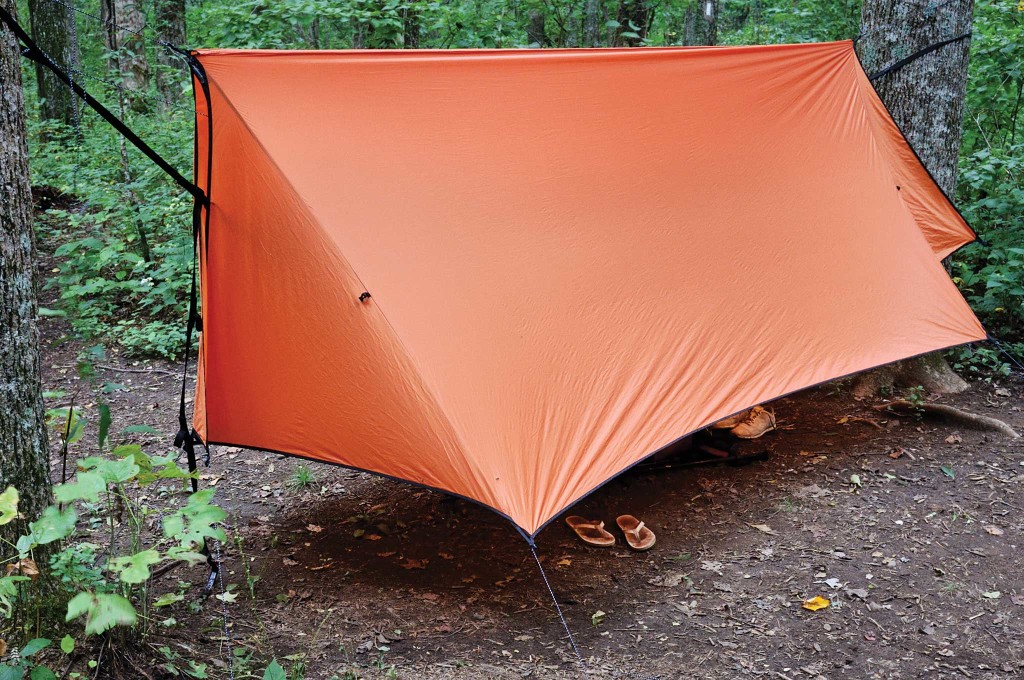
Even a small tarp can be an improvised shelter or rainwater collector. They're light, don't take up much...
JN: The No. 1 most important thing is to be educated. Be educated about how to use your equipment, be proficient with a map and compass, and with survival in your locale. Even Les Stroud, TV's Survivorman, educates himself with local survival skills before each adventure. Seek out local experts or join local outdoor clubs to learn some hands-on basic skills. If you can't do that, read as much as you can. A myriad of books and articles have been written on the subject of survival, hiking, and camping. Read them and then practice using those skills in a safe place, before you need to use them in a potentially life-threatening scenario.
GP: Stay calm and prioritize which tasks need to be accomplished first. Always let someone know where you're going and when you expect to return. If you're a hunter and not sure of your route, then at least let someone know which areas or creek drainages you expect to be in. A small first-aid kit with a couple of ACE wraps and SAM splints isn't that heavy and doesn't take up a lot of space. These items can make the difference between being able to make it back to the trail head/camp, or spending an unplanned night in the woods.
The 10 essentials varies a bit from person to person and locale to locale. What you would carry in the forests of Maine is somewhat different than the tundra of the arctic or the deserts of the Southwest. Here is certified SAR tech Joey Nickischer's 10 essentials list.
1. Water: Sufficient for environment, but 2 liters is a good reference point
2. Map: Paper topographic trail map preferred but others might suffice
3. Compass: Orienteering type, with sight (such as the Silva Ranger)
4. Flashlight: Something better than a $0.99 special
5. Knife: I'm a big fan of the older USAF survival knife, but even a small Swiss Army style or multitool is good.
6. Fire-starter: Magnesium fire-starter has been my choice for decades.
7. First-aid kit: Basic stuff including Band-Aids, gauze roll, tape, ACE bandage, and moleskin
8. Whistle: This is for signaling if you need assistance.
9. Extra clothing: Type depends on climate and weather conditions, but a change of socks, a hat, etc.
10. Shelter: Even a simple tarp can help keep you dry and warm, plus the typical royal blue stands out better than blaze orange in most environments.
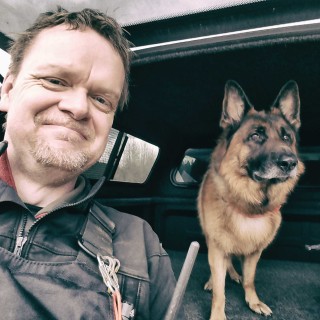 Hank Janssen
Hank Janssen
Based in the Pacific Northwest, Janssen is a former Army Special Forces soldier and lifelong backpacker. He started doing SAR with his first German Shepherd, Drakuul, in 1995. For the last 15 years he's taught survival and backcountry navigation classes and just started his current German Shepherd, Oberon, about a year-and-a-half ago. They are part of a K9 volunteer organization called German Shepherd Search Dogs of Washington State (www.gssd.org). The organization officially formed in 1969. Maintaining a K9 specialization within the SAR community is no small task.
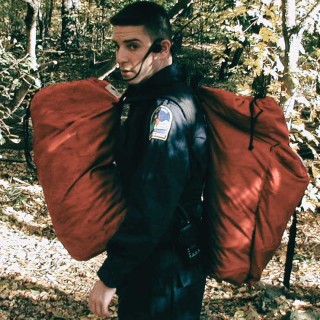 Joey Nickisher
Joey Nickisher
A nationally certified Search and Rescue Technician 1 Lead Evaluator (SARTECH1), Nickischer is also a retired New York City Police Department Detective. He currently works as a lead technical rescue instructor for RIT Safety Solutions, AAA Emergency Supply, and Newburgh Rescue Supply. On the volunteer side, Joey is the chief of New York Search & Rescue and has led his team through searches ranging from the Word Trade Center attacks to Hurricane Katrina-ravaged New Orleans to the Catskill Mountains. He serves as a team leader with the Westchester County Technical Rescue Team and the Putnam County Technical Rescue Team, as well as an Assistant Chief with the Patterson Fire Department.
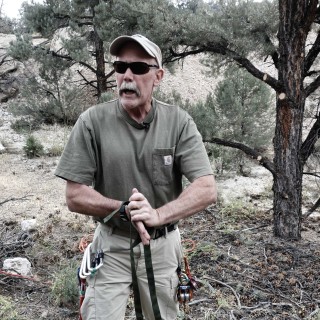 Gary Presson
Gary Presson
Gary Presson is retired from the military after more than two decades of service. He has 21 years as a military and SAR land navigation instructor, as well as seven years as a rope rescue instructor, teaching both military and civilian SAR teams. He's been an SAR volunteer since 2008 and is the lead instructor at North 40 Rescue, an SAR training firm with a focus on technical rope rescue that works with military and government units, volunteer fire departments, and civilian SAR teams around the country.
Don’t miss essential survival insights—sign up for Recoil Offgrid's free newsletter today!
Read articles from the next issue of Recoil Offgrid: Issue 25
Read articles from the previous issue of Recoil Offgrid: Issue 23
Check out our other publications on the web: Recoil | Gun Digest | Blade | RecoilTV | RECOILtv (YouTube)
Editor's Note: This article has been modified from its original version for the web.
 STAY SAFE: Download a Free copy of the OFFGRID Outbreak Issue
STAY SAFE: Download a Free copy of the OFFGRID Outbreak Issue
No Comments